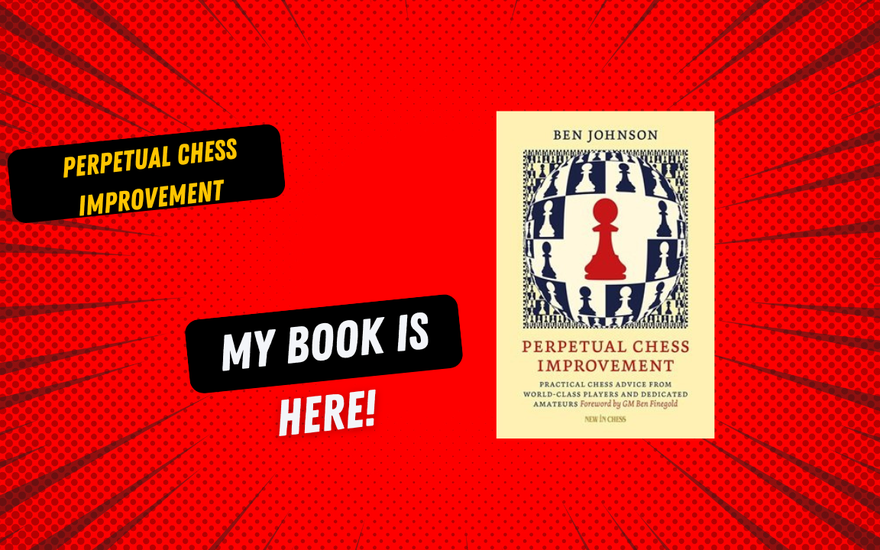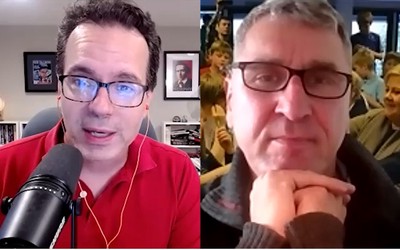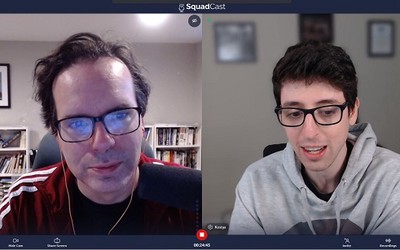
My Book is Out Today! Here Are a Few More Things I Wish I Included In It
Improving Perpetual Chess ImprovementWaiting for your book to be fully released into the world feels a bit like sitting in a roller coaster as it inches toward the apex, poised to turn downward. It is too late to change the decisions that got you to that point, it is time to hold on and hope for the best.
Today, as Amazon finally starts shipping it, my book is available basically everywhere. And while I have been encouraged that Perpetual Chess Improvement has gotten mostly positive receptions so far, there are already a few things I would change if I could. I am sure I will become aware of more desired amendments as I continue to receive feedback on the book and continue to interview people and learn ever more about how to improve at chess.
Here are 4 changes I would already make to my book if I could. (Minor spoilers forthcoming.)
1. One needs not only a study routine but, ideally, a structured study plan.
This was a point raised in a review by GM Jesse Kraai and he is right. Some players do manage to improve with a somewhat scattershot approach, but if you are a working adult trying to get better at chess, you are doing yourself a disservice if you don’t take advantage of the structure that coaches and cohorts like the ChessDoJo and Chessgoals can provide. I should have highlighted the importance of a structured plan somewhere in the book.
2. I forgot to include an important piece of advice for ambitious young adult chess players- The time for chess improvement is now!
Like a lot of chess players, I played quite actively and improved the most in my teenage years. My play slowed down when I went to university, and then through most of my 20s I was not pursuing tournament chess seriously. These days, in my 40s, I am back on the chess grind, but time is scarce. When Dr. Christopher Chabris interviewed me about the book, he asked if I ever regretted that approach, as I possibly could have achieved more as a player if I hadn’t skipped those years. I sensed that this was also a question that Dr. Chabris,(who is a USCF Master as well as an accomplished cognitive scientist) had grappled with himself. As Dr. David Eagleman has written “brain plasticity declines with age.” and this likely means that it gets more challenging to improve at chess (particularly at calculating), as you get older. This does not mean that one cannot improve at chess past the age of 30, in the book I share some inspiring stories of improvers of all ages, but chess improvement does get more challenging as one faces the double whammy of less energy and less time. But for me, studying more chess in my 20s would not have been the best choice, I had a lot to figure out in my 20s on a personal and professional level, and chess was pretty low on my list of priorities. But if you are young and have the desire and bandwidth to devote a lot of time to chess improvement it is a good phase of life to do it, as it doesn’t get any easier as the years go on.
3. Part of the reason that people studied the classics so often, is that they had no other games to study!
One of the many recurring chess improvement debates that I address in the book is “Do we still need to study the classics?” My answer, somewhat reluctantly, is that if our only goal is to get better at chess, we no longer need to study them. I stand by that assertion, but after the draft was turned in, I heard renowned author GM Jacob Aagaard make an important additional point on the Chess Journeys Podcast. Jacob said that the reason the classics became the classics is that in those days there were very few games to study! These days, there are millions of games to comb through, and we can see original instructive positions from modern games without needing to endlessly repeat the old ones. I was glad to hear that GM Aagaard broadly backed up my assertion, but I wish I had thought of that specific point when writing the book. By the way, I still enjoy tracing the evolution of chess learning through history, I just don't view it as vital to chess improvement.
4. I neglected a few details about Solitaire Chess.
In my book, I discuss the idea of using “solitaire chess” or “guess the move” as a training method. Top trainers and players like GM Gregory Kaidanov and GM Alex Fishbein have explained its benefits in interviews, and it can be a fun way to learn more about players and to actively practice all phases of the game. There are a few additional points I wish I had raised. 1. In addition to mimicking solitaire chess in LiChess studies, or on Chessbase (as I mentioned), one can also play solitaire chess on Forward Chess and ChessTempo (which I didn’t mention) . 2. I forgot that one, of course, should write down the moves when “playing” solitaire chess. My friend FM Nate Solon highlighted this and some other helpful points when he recently wrote about it.
So I am sure that I will have more amendments and would be do-overs as time goes on, but overall I am happy with the book I have written. If you would like to know more about the book, New in Chess has shared a free excerpt here, and I also made a short video preview of the book. If you decide to check out the book, I hope you enjoy it!
More blog posts by PerpetualChess

Life and Chess Improvement Lessons from GM Simen Agdestein
Magnus Carlsen’s Childhood Coach on the Joys of Keeping Things Simple
GM Michael Adams and Philip Hurtado on How to "Think Like a Super GM"
An Excellent new chess book puts a 21st century spin on the research of Adriaan de Groot
3 Conclusions and 3 goals from a Data Analysis of my 24 Recent Tournament Games
Using Data to Assess "The State of My Chess Game"